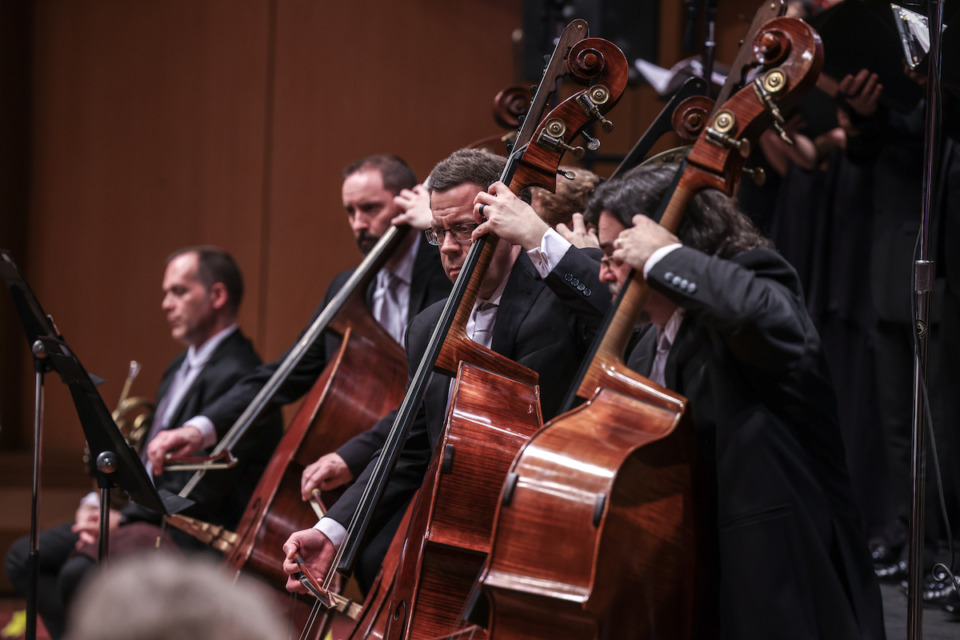As we seek shelter from the sweltering charms of the summer season, our thoughts turn to autumn. The leaves will turn, the air will grow crisp and our brilliant friends at the Memphis Symphony Orchestra (MSO) will commence their new concert season.
From premieres to timeless classics, the MSO is set to provide a musical feast for symphony enthusiasts and newcomers alike. Here are the highlights for fall 2023.
“Pictures at an Exhibition” and Chris Brubeck guitar concerto
- Saturday, Sept. 30, 2023 · 7:30 p.m. · Cannon Center for the Performing Arts
- Sunday, Oct. 1, 2023 · 2:30 p.m. · Scheidt Family Performing Arts Center
- Robert Moody, conductor. Thomas Flippin, guitar. Vasti Jackson, guitar
Kicking off the season, MSO presents an attractive combination of pieces, including the world premiere of Chris Brubeck’s “Double Guitar Concerto.” Under the baton of Robert Moody, the MSO will, on this occasion, be joined by guitarists Thomas Flippin and Vasti Jackson.
In our interview, Moody was particularly enthused about this program. Chris Brubeck, Moody told me, wrote the piece to feature one classical and one blues guitar.
“It is a very nice tribute to Memphis. The classical guitarist is out of New England, his name is Thomas Flippin, a phenomenal player. The blues guitarist is the excellent Vasti Jackson, out of Mississippi. It is a 28-minute concerto and uses the orchestra beautifully as a sometimes classical, sometimes jazz linking mechanism between the classical and blues guitars. It is very virtuosic and has a big, satisfying ending. I think this will be the first of its many performances.”
The second half of the concert opens with Christopher Theofandis’ “Rainbow Body.” The piece has a duration of roughly 13 minutes and is composed in a single movement.
Its captivating melody draws loose inspiration from “Ave Maria, o auctrix vite,” a chant by the prominent 12th-century composer Hildegard of Bingen.
The piece derives its name from the concept of the Tibetan Buddhist “rainbow body,” wherein the body of an enlightened being is absorbed back into the universe upon their death.
The concert ends with the spectacular sounds of Ravel’s orchestration of Mussorgsky’s masterpiece, “Pictures at an Exhibition.”
Moody conducts ‘Beethoven 5’
- Friday, Oct. 13, 2023 · 6:30 p.m. · Crosstown Theater
- Sunday, October 15, 2023 · 2:30 p.m. · Scheidt Family Performing Arts Center
- Robert Moody, conductor. Caroline Kinsey, horn
Fate will come knocking at the door as the transcendent power of Ludwig van Beethoven’s “Symphony No. 5 in C minor, Op. 67,” takes center stage in this MSO concert event. Composed between 1804 and 1808, this timeless masterpiece stands as one of the most renowned and frequently performed symphonies in the classical music repertoire.
Regarded as a cornerstone of Western music, its inaugural performance at Vienna’s Theater an der Wien in 1808 sparked its prodigious rise to prominence. Earning accolades from E. T. A. Hoffmann, who hailed it as “one of the most important works of the time,” Beethoven’s “Fifth Symphony” embodies the essence of the Classical period with its four exquisite movements.
The concert also features Mason’s festive “Inspiration! Festive Overture” and Lazarescou’s “Impressions from the Black Sea.”
Master Series: ‘Carmina Burana’
- Saturday, Oct. 28, 2023 · 7:30pm · Cannon Center for the Performing Arts
- Robert Moody, conductor
- Memphis Symphony Chorus. Lawrence Edwards, conductor
- University of Mississippi University Choir. Donald Trott, director
Well, here comes fate again. Step into the captivating world of “Carmina Burana,” a remarkable cantata brought to life by Carl Orff during the years 1935 and 1936.
Drawing inspiration from a collection of 24 medieval poems known as “Carmina Burana,” Orff’s composition weaves a tapestry of musical narrative that continues to captivate audiences to this day.
I am sure you have all heard the opening “Fortuna” chorus, with its dramatic chanting against orchestral backing. It often adds drama and a sense of epic scale to movies, commercials, and reality shows.
This is undoubtedly one of the most popular works for choir and orchestra of the 20th century. It is also one of the most misunderstood ones. Being sung in Latin, “Carmina Burana” is often perceived as a thematically serious work. The texts cover a wide range of topics, however, as familiar in the 13th century as they are to us in our day: the fickleness of fortune and wealth, the ephemeral nature of life, the joy of the return of spring, and the pleasures and perils of drinking, gluttony, gambling and lust. Much of it is about drinking, sex and medieval monks. I hope the text translation will be provided.
If this is not enough, you can also hear Death playing the fiddle while the dead he called forth from their graves dance. That is the basic premise of “Danse Macabre,” a tone poem by the French composer Camille Saint-Saëns.
The MSO will be joined on this occasion by the Memphis Symphony Chorus and the University of Mississippi University Choir.
Are you curious now? Well, come and hear it!
Žak Ozmo
